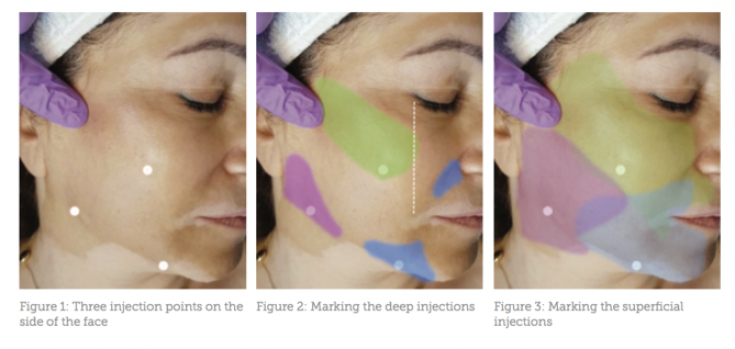Obtaining the optimal result of facial rejuvenation is not easy, because for this the cosmetologist must meet the high requirements of the patient and carry out complex work with fat compartments at different depths, tighten the upper and lower, and also volumize the middle third of the face. The end result should be noticeable to the patient, and the attractiveness of – not broken. Fortunately, the modern esthetician can choose the most suitable global facial rejuvenation technique for a particular patient. The purpose of most of them – tissue volumization or stimulation of collagenogenesis with fillers. This article estet-portal.com provides Dr. Ayad Harb's protocol for lifting and facial rejuvenation through three points.
- Three-Point Lifting Protocol: Key Tasks and Filler Selection
- Description of the three lifting points and procedure protocol
- Results of facial rejuvenation with fillers based on
- polycaprolactone base Three point lifting protocol: main tasks and filler selection
"Three Point Lift"
– a protocol designed for global facial rejuvenation with polycaprolactone filler, which is based on an uncomplicated integrated approach to the correction of deep and superficial fat through 3 starting points.Read also:
Neck rejuvenation with thread lifting The second, but no less significant goal of the – stimulate the natural production of new collagen fibers in the subdermal layer and superficial facial fat packs.

Fig. 1: three insertion points on one side of the face
Fig. 2: deep injection markup
Fig. 3: markup of surface injections
Fillers based on polycaprolactor microspheres, in addition to good volumization, provide powerful stimulation of the synthesis of collagen
I type in the skin. For a facelift through three points, it is permissible to use other fillers, however, it is polycaprolactone that triggers the production of collagen fibers mainly of type I, and not I and III, as is the case with other filler gels.
Description of the three lifting points and protocol for the procedure The effect of correction with fillers based on polycaprolactone lasts from 1 to 5 years.Deep plane correction
involves the administration of boluses of 0.1-0.2 ml of the drug into fat pads (Fig. 2). To rejuvenate the entire face, you will need 0.5-3 ml of gel, depending on the deficit of volumes.Read more of our content on
Facebook! Correction in the superficial plane is performed using microboluses of filler with a volume of 0.02-0.05 ml, which are injected subdermally in a linear technique (Fig. 3). The centered point allows the cannula to rotate 360o
.Point #1
Location – center of zygoma.Allows you to inject the drug at
:
deep fat compartments of the middle third of the face (supraperiostally); temporal zone (supraperiostally);
- pre-zygomatic zone (supraperiosteally);
- the entire middle third of the face (superficially);
- nasolabial connection (for superficial biostimulation of the upper lip).
- Point #2
Allows to work with
:
the area around the mouth, including superficial biostimulation; lower third, including periosteum in the area of the facial oval.
-
Point #3
Designed for
:
periosteal injection of the filler along the posterior edge of the mandible, creating a clear angle of the mandible; superficial injection of the drug in the upper part of the neck, along the jaw line and
- in front of the parotid gland.
- Results of facial rejuvenation with polycaprolactone fillers Face correction with polycaprolactone fillers according to the "Three Points Lifting" protocol provides:
volumization of deep fat pads;
reinforcement of bony prominences;
- superficial infiltration of filler microspheres over the entire face.
- Immediately after the procedure, a pronounced increase in volumes
- is noticeable, side effects include moderate swelling and erythema of the skin. One of the advantages of the described technique is the minimal likelihood of hematoma formation.
Injection points are treated with antibacterial ointment after the correction is completed, and the patient can apply makeup if desired before leaving the doctor's office.
The filler that Dr. Harb uses in the Three Point Lift protocol consists of polycaprolactone microspheres and carboxymethyl cellulose gel (30% and 70% of the drug, respectively).After facial rejuvenation with polycaprolactone fillers:
the result becomes less pronounced within 4–6 weeks after correction; after 6 weeks, the volumes increase, the skin becomes softer and more toned;
- after about 3–6 months the result will stabilize;
- The long-term effect (1–5 years) is mainly due to neocollagenesis.
- Ideal patients
- for facial rejuvenation with polycaprolactone fillers through 3 points:
age 30–50 years; mild to moderate volume loss;
- mild to moderate skin laxity.

Three Point Lifting Protocol also matches:
for the prevention of skin aging (for patients whose collagen levels begin to decline); to prepare for more invasive facial rejuvenation procedures (thread lift, surgery).
- Taking into account the peculiarities of the increase in the result after the introduction of fillers based on polycaprolactone, it is important to inform patients in advance about all these nuances.
- Adapted from Aesthetics.
See also the video on our
YouTube







Add a comment